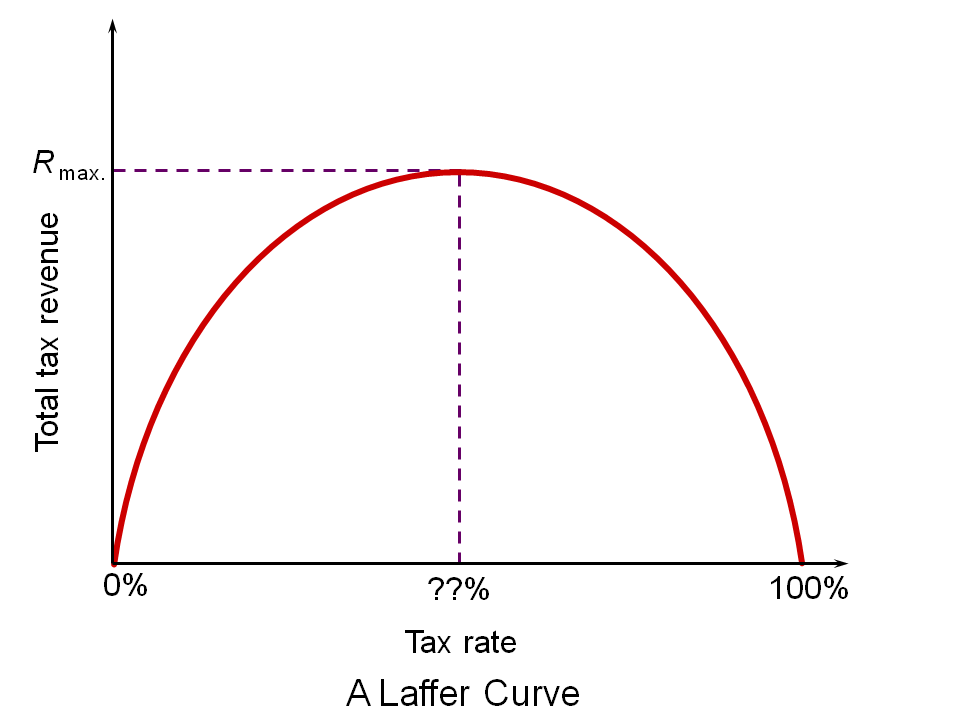The 50p income tax rate and the Laffer curve (update)
 Recently there have been calls from business leaders and Conservative politicians to scrap the UK’s 50% income tax rate, which is paid on taxable incomes over £150,000. The 50% income tax rate is thus paid by top earners, who comprise around just 1% of taxpayers.
Recently there have been calls from business leaders and Conservative politicians to scrap the UK’s 50% income tax rate, which is paid on taxable incomes over £150,000. The 50% income tax rate is thus paid by top earners, who comprise around just 1% of taxpayers.
And yet the government receives about 30% of income tax revenue from this 1% – and this was before the introduction of the 50% rate in April 2010. (In fact, with the marginal national insurance rate of 2%, top earners are paying an effective marginal rate of 52%.)
One argument used by those who favour reducing the 50% rate is that the rich would pay more income tax, not less. There are four reasons given for this. The first is that people would be encouraged to work harder and/or seek promotion if they knew they would keep more of any rise in income. The second is that fewer rich people would be encouraged to leave the country or to relocate their businesses abroad. The third is that more people would be encouraged to work in or set up businesses in the UK. The fourth is that there would be less temptation to evade taxes by not declaring all income earned or to find clever ways of avoiding tax.
These arguments were put forward in the 1980s by Art Laffer, an adviser to President Reagan. His famous ‘Laffer curve’ (see Economics (8th edition) Box 10.3 or Economics (7th edition) Box 10.4) illustrated that tax revenues are maximised at a particular tax rate. The idea behind the Laffer curve is very simple. At a tax rate of 0%, tax revenue will be zero – but so too at a rate of 100%, since no-one would work if they had to pay all their income in taxes. As the tax rate rises from 0%, so tax revenue would rise. And so too, as the tax rate falls from 100%, the tax rate would rise. It follows that there will be some tax rate between 0% and 100% that maximises tax revenue.
Those arguing that a cut in the top rate of income tax would increase tax revenue are arguing that the 50% rate is beyond the peak of the Laffer curve. But this is an empirical issue. In other words, to assess the argument you would need to look at the evidence as, theoretically, the peak of the Laffer curve could be below or above 50%. Indeed, some argue that the peak is more likely to be at around 75%.
The following podcasts and articles consider the arguments. As you will see, the authors are not all agreed! Consider carefully their arguments and try to identify any flaws in their analysis.
Update
On 27 June 2012, Arthur Laffer appeared on the BBC Today Programme to discuss the Laffer curve and its implications for UK income tax policy. You can hear it from the link below
Podcasts Should the 50p tax rate be ditched? BBC Today Programme, John Redwood and Paul Johnson (3/3/12)
Should the 50p tax rate be ditched? BBC Today Programme, John Redwood and Paul Johnson (3/3/12) Arthur Laffer: Tax rate should ‘provide for growth’ BBC Today Programme (27/6/12)
Arthur Laffer: Tax rate should ‘provide for growth’ BBC Today Programme (27/6/12)
Articles
Where’s the High Point on the Laffer Curve? And Where Are We? Business Insider, Angry bear Blog (3/3/12)
Tax cuts: we can have our cake and eat it The Telegraph, Ruth Porter (22/2/12)
‘Scrap the 50p tax rate’ say 500 UK entrepreneurs Management Today, Rebecca Burn-Callander (1/3/12)
The Laffer Curve Appears in the UK Forbes, Tim Worstall (22/2/12)
Memo to 50p tax trashers: Laffer Curve peaks at over 75 per cent Left Foot Forward, Alex Hern (1/3/12)
Questions
- Explain how a cut in income tax could lead to an increase in tax revenue.
- Distinguish between the income effect and the substitution effect of a tax cut. Which would have to be bigger if a tax cut were to increase tax revenue?
- If, in a given year, the top rate of tax were raised and tax revenue fell, would this prove that the economy was now past the peak of the Laffer curve?
- What would cause the Laffer curve to shift/change shape? To what extent could the government affect the shape of the Laffer curve?
- If the government retains the 50% top tax rate, what can it do to increase the revenue earned from people paying the top rate?
- What other objectives might the government have for having a high marginal income tax rate on top earners?
- Investigate the marginal income tax and national insurance (social protection) rates in other countries. How progressive are UK income taxes compared with those in other countries?